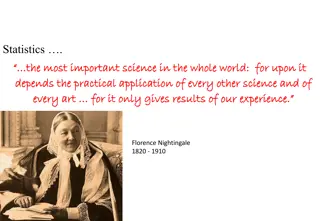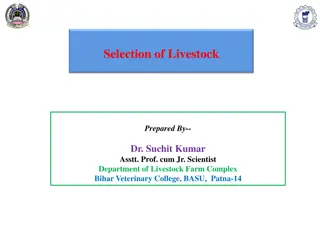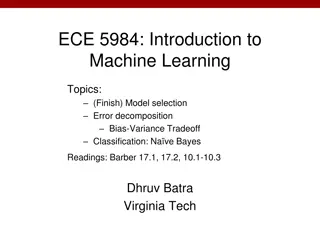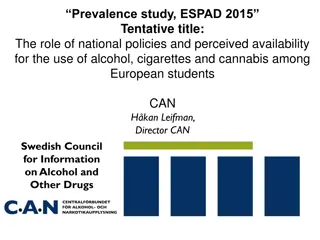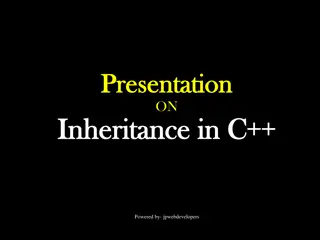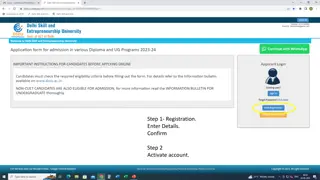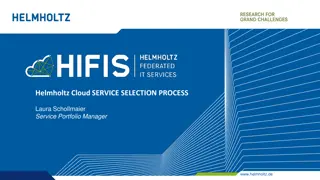A Comprehensive Guide to Multilevel Model Selection
Explore mlmeval as a postestimation tool for assessing multilevel model fit and adequacy. Learn about R2 measures, Rights & Sterba's framework, and two-level linear mixed models illustrated with examples and code snippets.
Download Presentation

Please find below an Image/Link to download the presentation.
The content on the website is provided AS IS for your information and personal use only. It may not be sold, licensed, or shared on other websites without obtaining consent from the author. Download presentation by click this link. If you encounter any issues during the download, it is possible that the publisher has removed the file from their server.
E N D
Presentation Transcript
mlmeval: Complementary Tools for an Integrated Approach to Multilevel Model Selection Anthony J. Gambino, PhD Sarah D. Newton, PhD D. Betsy McCoach, PhD University of Connecticut
Introduction mlmeval is a postestimation command to be used after running mixed to aid users in assessing the fit and adequacy of their multilevel models. Model fit fit in the form of extensive information criteria options. Model adequacy adequacy in the form of R2measures defined for multilevel models (Rights & Sterba, 2019a), the focus of this presentation due to it being a relatively new approach.
Background McCoach, D. B., Newton, S., & Gambino, A. J. (2022). Evaluation of model fit and adequacy. In A. A. O Connell, D. B. McCoach, & B. A. Bell (Eds.), Multilevel modeling methods with introductory and advanced applications (pp. 51 94). Information Age Publishing. Chapter included explanations and example code to calculate IC and R2measures in R, but the code is cumbersome, especially for the R2measures.
Multilevel Model Adequacy: R2Measures For decades, the only available R2measures for MLM were limited in terms of what they could accurately describe, how completely they could partition the outcome variance, the models they could be applied to, and their accessibility via literature and software implementation.
Multilevel Model Adequacy: R2Measures Rights & Sterba (2019a, 2022) proposed a general framework for defining R2measures for MLM based on a full decomposition of the outcome variance.
Multilevel Model Adequacy: R2Measures For simplicity, we ll just focus on 2-level models. It s straightforward to extend it to more than two levels (Rights & Sterba, 2022). The framework can theoretically accommodate any number of levels.
Two-Level Linear Mixed Model ? + ??? ??+ ??? ???= ??? ???~? 0,?2 ??~???(?,?)
? + ??? ??+ ??? ???= ??? Level 1 Pred. ? Level 2 Pred. ? ???= {1, ?1??, ,???? * *note: Level note: Level- -1 Pred. s include Cross 1 Pred. s include Cross- -Level Interaction Terms! ,??+1??, ,??+??? } Level Interaction Terms! ? = ?0, ,??+?+?? = Fixed Effects ???= 1,?1??, ,???? = Level-1 Pred. s w/ Random Slopes ??= ?0?, ,??? = Random Effects
Two-Level Variance Decomposition (Rights & Sterba, 2019a) var ??? = ? ?? + ?? ?? + ? ?? + ?2 ? = var ??? ? = var ??? ? = var ?? ? = E ???
Two-Level Variance Decomposition = ? ?? Variance explained by all pred. s via fixed slopes + ? ?? Variance explained by cluster specific outcome means via random intercept variation ?2 var ??? + ?? ?? Variance explained by level 1 pred. s via random slope variation + Level 1 residual variance Model implied total outcome variance
Full Variance Decomposition (cwc) It s possible to compute total R2measures with these components. However, the outcome variance can be further decomposed if we cluster-mean center our data (often called centering-within-cluster, or cwc). Doing so allows us to compute both total and level- specific R2measures.
Full Two-Level Variance Decomposition (cwc) ?2?2 Variance explained by level 2 pred. s via fixed slopes ?1?1 Variance explained by level 1 pred. s via fixed slopes ?2 var ??? = ?1 + ?2 + ?? ?? Variance explained by level 1 pred. s via random slope variation + ?00 + Level 1 residual variance Variance explained by cluster specific outcome means via random intercept variation Model implied total outcome variance
Full Two-Level Variance Decomposition (cwc) ? ?? ? ?? ?1?1+ ?2 ?2?2 + ?2 + ?? ?? + var ??? = ?1 ?00 ?1= var.-cov. matrix of level-1 predictors ?2= var.-cov. matrix of level-2 predictors ?00= random intercept variance
R2Measure Interpretation ? ?? Proportion of total variance explained by all predictors via fixed slopes. all predictors via fixed slopes. by 2 ?= ?? var ??? Proportion of total variance explained by level level- -1 predictors via random slope 1 predictors via random slope (co)variation. (co)variation. by ?? ?? 2 ?= ?? var ??? Proportion of total variance explained by cluster cluster- -specific outcome means via specific outcome means via random intercept variation. random intercept variation. by ? ?? 2 ?= ?? var ???
R2Measure Interpretation Proportion of total variance explained by all predictors via fixed by all predictors via fixed slopes and random slope slopes and random slope (co)variation. (co)variation. 2 ??= ?? 2 ?+ ?? 2 ? ?? 2 ??? ?? = ?? Proportion of total variance explained by the model. by the model. 2 ?+ ?? 2 ?+ ?? 2 ? 2 ??? Proportion of unexplained variance. unexplained variance. 1 ??
R2Measure Interpretation ?1?1 var ??? 2 ?1=?1 Proportion of total variance explained by level level- -1 predictors via fixed slopes. 1 predictors via fixed slopes. by ?? ?2?2 var ??? 2 ?2=?2 Proportion of total variance explained by level level- -2 predictors via fixed slopes. 2 predictors via fixed slopes. by ?? 2 ? ?? = ?? Proportion of total variance explained by all predictors via fixed slopes. all predictors via fixed slopes. by 2 ?1+ ?? 2 ?2
R2Measure Interpretation 2 ?1 ?1 Proportion of level-1 variance explained by level by level- -1 predictors via fixed slopes. fixed slopes. ?1?1 ?1 1 predictors via = ?1?1+ ?? ?? + ?2 ?1 2 ? ?1 Proportion of level-1 variance explained by level by level- -1 predictors via random slope (co)variation. random slope (co)variation. ?? ?? 1 predictors via = ?1?1+ ?? ?? + ?2 ?1 Proportion of level-1 variance explained by the model. by the model. 2 ?1?= ?1 2 ?1+ ?1 2 ? ?1
R2Measure Interpretation Proportion of level-2 variance explained by level by level- -2 predictors via fixed slopes. fixed slopes. ?2?2 ?2?2+ ?00 ?2 2 ?2= ?2 2 predictors via ?2 Proportion of level-2 variance explained by cluster by cluster- -specific outcome means via random outcome means via random intercept variation. intercept variation. ?00 specific 2 ?= ?2 ?2?2+ ?00 ?2 2 ?can be thought of as the ?2 proportion of unexplained level-2 variance. 2 ?2+ ?2 2 ?= 1 Note: ?2
R2Measures: Software Implementation Shaw et al. (2022) contributed an R package (r2mlm) that can implement the framework. This package can automatically fill in the necessary information for the user based on an lme4/nlme model object, but it currently can only do this for limited cases. Outside of those specific cases, this package requires the user to plug in model estimates and information about the predictors used in the model like which ones had random effects and which levels they exist on.
mlmeval implementation of R2Framework mlmeval does not require the user to provide any information. Simply run it after a completed mixed command and it will find the necessary information from the stored estimates and the ereturn list macros/matrices. mlmeval allows up to 5-level models.
Syntax mlmeval [, options] options Main cwc r2 ic Description use full variance decomposition only compute R^2 measures only compute information criteria
Future Directions Allowing factor variables in model equation Model Comparisons (Rights & Sterba, 2019b) mlmeval mod1 mod2 R2Extensions including measures for: Longitudinal Growth models (Rights & Sterba, 2021) Mixed-Effects Location Scale models (Zhang & Hedeker, 2022) Generalized Linear Mixed Models (in development) Cross-Classified Models (in development)
Thank you! Email us at: anthony.gambino@uconn.edu sarah.newton@uconn.edu betsy@uconn.edu
References Akaike, H. (1973). Information theory and an extension of the maximum likelihood principle. In B. N. Petrov & B. F. Csaki (Eds.), Second International Symposium on Information Theory, (pp. 267-281). Academiai Kiado. Boekee D.E., Buss H.H. (1981). Order estimation of autoregressive models. In Proceedings of the 4th Aachen colloquium: Theory and application of signal processing (pp. 126-130). Bozdogan, H. (1987). Model selection and Akaike s Information Criterion (AIC): The general theory and its analytical extensions. Psychometrika, 52(3), 345-270. https://doi.org/10.1007/BF02294361 Haughton, D. M. A. (1988). On the choice of a model to fit data from an exponential family. The Annals of Statistics, 16(1), 342 355. Hannan, E. J. & Quinn, B. G. (1979). The determination of the order of an autoregression. Journal of the Royal Statistical Society Series B (Methodological), 41(2), 190-195. https://doi.org/10.1111/j.2517-6161.1979.tb01072.x Hurvich, C. M. & Tsai, C. (1989). Regression and time series model selection in small samples. Biometrika, 76(2), 297-307. https://doi.org/10.1093/biomet/76.2.297 McCoach, D. B., Newton, S., & Gambino, A. J. (2022). Evaluation of model fit and adequacy. In A. A. O Connell, D. B. McCoach, & B. A. Bell (Eds.), Multilevel modeling methods with introductory and advanced applications (pp. 51-94). Information Age Publishing.
References (cont.d) Rights, J. D., & Sterba, S. K. (2019a). Quantifying explained variance in multilevel models: An integrative framework for defining R-squared measures. Psychological Methods, 24(3), 309-338. http://dx.doi.org/10.1037/met0000184 Rights, J. D., & Sterba, S. K. (2019b). New recommendations on the use of R-squared differences in multilevel model comparisons. Multivariate Behavioral Research, 55(4), 568-599. https://doi.org/10.1080/00273171.2019.1660605 Rights, J. D., & Sterba, S. K. (2021). Effect size measures for longitudinal growth analyses: Extending a framework of multilevel model R-squareds to accommodate heteroscedasticity, autocorrelation, nonlinearity, and alternative centering strategies. Child and Adolescent Development, 65-110. https://doi.org/10.1002/cad.20387 Rights, J. D., & Sterba, S. K. (2022). R-squared measures for multilevel models with three or more levels. Multivariate Behavioral Research. https://doi.org/10.1080/00273171.2021.1985948 Schwarz, G. (1978). Estimating the dimension of a model. The Annals of Statistics, 6(2), 461 464. Sclove, S. L. (1987). Application of model-selection criteria to some problems in multivariate analysis. Psychometrika, 52(3), 333-343. Shaw, M., Rights, J. D., Sterba, S. K., & Flake, J. K. (2022). R2mlm: An R package calculating R-squared measures for multilevel models. Behavior Research Methods. https://doi.org/10.3758/s13428-022-01841-4 Zhang, X., & Hedeker, D. (2022). Defining R-squared measures for mixed-effects location scale models. Statistics in Medicine, 1-17. https://doi.org/10.1002/sim.9521
Appendix: Model Fit: Information Criteria mlmeval provides the deviance, AIC, and AIC3, as well as: AICC CAIC BB1A HBIC BIC HQIC SABIC For each possible sample size, including the effective sample size (Neff).




